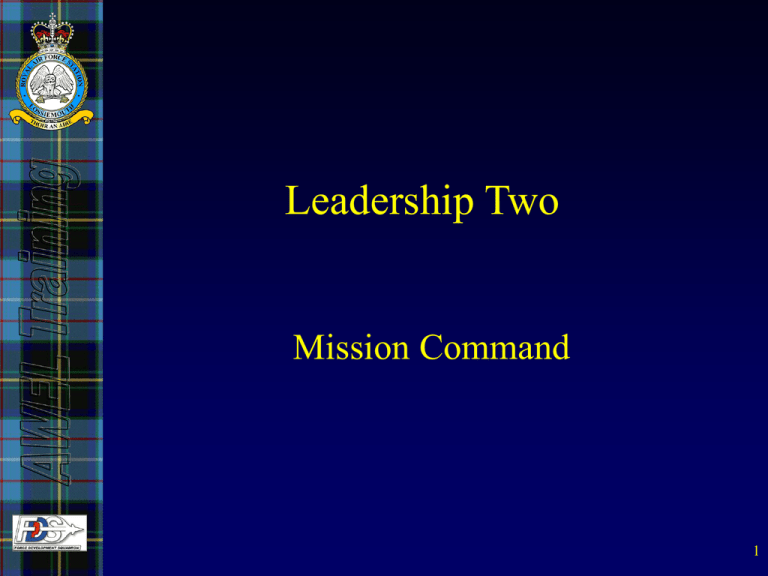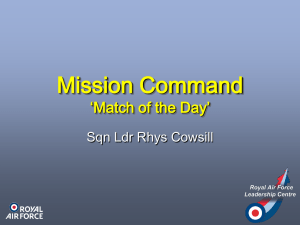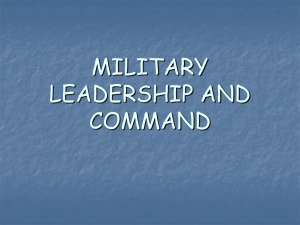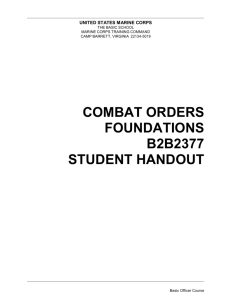missions
advertisement

Leadership Two Mission Command 1 Scope • Concept & OODA Loop • Historical Context • Applying the Concept – Orders & Unity of Effort • Applying the Concept – Remaining Principles • Summary 2 Scope • Concept & OODA Loop • Historical Context • Applying the Concept – Orders & Unity of Effort • Applying the Concept – Remaining Principles • Summary 3 Tempo “1. (Music) Time, rapidity of movement; characteristic speed and rhythm of movement (waltz tempo). 2. (Figurative) Rate of motion or activity (the tempo of war is quickening). (Italian, from Latin tempus, time)” Oxford Concise Dictionary 4 The OODA Loop Observation Orientation Decision Action 5 Scope • Concept & OODA Loop • Historical Context • Applying the Concept – Orders & Unity of Effort • Applying the Concept – Remaining Principles • Summary 6 ‘Match of the Day’ 7 Match of the Day 1 14th October 1806 PRUSSIA (Professional and hot favourites) Vs FRANCE (Upstart peasants – New Manager) Venue: Jena and Auerstadt Kick-off: 3.00pm 8 Match of the Day 1 Meet the Personalities French Manager: Napoleon Bonaparte Prussian Manager: Scharnhorst 9 Match of the Day 1 Meet the Personalities Post-Match Analyst & Pundit: Field Marshal Von Molke 10 Match of the Day 1 Result France: Won Prussia: None! ‘We fought bravely enough, but not cleverly enough.’ 11 Match of the Day 1 Findings of Scharnhorst’s ‘Board of Inquiry • The Prussian Army was run as a machine, with iron discipline, because the morale of the troops was low • Officers tried to counter chaos of battle by using scientific principles • Nobody took action without orders • Highly centralized and process dominated • It used ‘Befehltaktik’ – i.e. based on orders 12 Match of the Day 1 Findings of Scharnhorst’s ‘Board of Inquiry • Napoleon was able to communicate very rapidly with his Marshals • He explained his intentions, as well as what he wanted them to do • He expected them to use their initiative • They did!!! • The result was a very high tempo – a very fast OODA loop 13 Match of the Day 1 • • • • Reforms to the Prussian Army The need for speed of decision making was recognized Officers were trained and authorized to make real-time decisions at low level Philosophy that it was better to act now with good intentions than to wait for the ‘right’ order Orders from above could not possibly give the officer on the ground all the guidance he would need 14 Match of the Day 1 Moltke’s Wisdom Father of ‘Auftragstaktik’ “Obedience is a principle, but the man stands above the principle.” 15 Auftragstaktik • Senior commanders should not order more than was absolutely necessary but should ensure the goal was clear. • In case of doubt, subordinate commanders should seize the initiative 16 Match of the Day 2 Franco-Prussian War 1870 Return (grudge) Match FRANCE Vs PRUSSIA Kick-off: 3.00pm 17 Match of the Day 2 Result Prussia: Won France: None! 18 Match of the Day 3 The Great War 1914 GERMANY (Ex Prussia) Vs COMBINED SERVICES (France/BEF) Kick-off: 3.00pm 19 Match of the Day 3 Post-Match Report • Owing to muddy conditions and outstanding new goalkeeping device (machine guns), match stagnates and goes into extra time. • OODA Loop goes from ‘observation’ to ‘action’ and back again. 20 Match of the Day 3 Post-Match Report •Observation Owing to muddy conditions and Decision Action Orientation outstanding new goalkeeping device (machine guns), match stagnates and goes into extra time. • OODA Loop goes from ‘observation’ to ‘action’ and back again. 21 Match of the Day 3 Post-Match Report • Owing to muddy conditions and outstanding new goalkeeping device (machine guns), match stagnates and goes into extra time. • OODA Loop goes from ‘observation’ to ‘action’ and back again. • Auftragstaktik comes on as late substitute and almost wins the game. 22 Match of the Day 4 Second World War 1939 ‘OLD FIRM’ GAME Venue: Various Kick-off: 3.00pm 23 Match of the Day 4 Post-Match Report • Germany has outstanding first half using Auftragstaktik from the ‘off’. • Big wins away in Poland, Czechoslovakia, Holland, Belgium, France, etc., etc.. • Manager substitutes Befehltaktik just after half time. • Germany loses away in Russia (Stalingrad City). • Loses to new Combined Services (US/UK). • Loses at home trying to play 2 games at once. 24 Cold War • Static posturing. • Everyone told what they had to do (Befehltaktik?). • Not ‘manoeuvre warfare.’ • Little need for Auftragstaktik. • But!!!! British Army on the Rhine is seriously outnumbered and so……. 25 Field Marshal Bagnall KCB GCB CVO MC* • Introduces the principles of Auftragstaktik to UK Military doctrine (1986) and influences NATO doctrine. • Doctrine becomes known as Mission Command. • Great idea! • ….but nobody knows about it… 26 Mission Command • Is designed to facilitate effective action under chaotic and confusing conditions. • Is based on trust. • Is intended to unify autonomy and alignment. • The ‘mechanics’ are as follows: 27 Mission Command • The Commander: – Briefs his intent to 2 levels down. – Explains the limitations; eg, time, boundaries, must do, mustn’t do. – Allocates resources. – States WHAT is to be achieved, not HOW it is to be achieved. – Gives decision-making criteria. 28 Mission Command • The Subordinate Commander: – Understands ‘my role in his plan’ 2 levels up. – Devises his own plan to play his part in achieving the commander’s intent. – Asks for more resources if needed, but offers back resources not needed. – Briefs his subordinates 2 levels down. 29 30 Scope • Concept & OODA Loop • Historical Context • Applying the Concept – Orders & Unity of Effort • Applying the Concept – Remaining Principles • Summary 31 Principles of Mission Command • Unity of effort 32 Achieving Unity of Effort • The Commander’s Intent • Main and Supporting Efforts • Mission Statements 33 • • • Orders Format Situation • Enemy Forces • Friendly Forces • Attachments and Detachments Mission Execution • Concept of Ops • • • • • Intent Scheme of Manoeuvre Main Effort • Subordinates’ missions • Coordinating instructions Service Support Command & Signal 34 • • • Orders Format Situation • Enemy Forces • Friendly Forces • Attachments and Detachments Mission Execution • Concept of Ops • Intent • • • • Scheme of Manoeuvre Main Effort • Subordinates’ missions • Coordinating instructions Service Support Command & Signal 35 “…One part of the order I did, however, draft myself - the intention. It is usually the shortest of all paragraphs, but it is always the most important, because it states - or it should - just what the commander intends to achieve. It is the one overriding expression of will by which every action by every commander and soldier in the army must be dominated.” Defeat Into Victory Field Marshal Slim 1944 36 Commander’s Intent - Overview A succinct summary of how he proposes to achieve his purpose - articulated through effects, so subordinates understand the links between Main and Supporting Efforts. Also a description of how he thinks achieving his task will meet his given purpose (his unique contribution to his superior’s intent) 37 Commander’s Intent - Overview A succinct summary of how he proposes to achieve his purpose - articulated through effects, so subordinates understand the links between Main and Supporting Efforts. Also a description of how he thinks achieving his task will meet his given purpose (his unique contribution to his superior’s intent) 38 • • • Orders Format Situation • Enemy Forces • Friendly Forces • Attachments and Detachments Mission Execution • Concept of Ops • • Intent Scheme of Manoeuvre • Main Effort • • • Subordinates’ missions • Coordinating instructions Service Support Command & Signal 39 Main Effort A concentration of forces or means, in a particular area, where a commander seeks to bring about a decision 40 • • • Orders Format Situation • Enemy Forces • Friendly Forces • Attachments and Detachments Mission Execution • Concept of Ops • • • Intent Scheme of Manoeuvre Main Effort • Subordinates’ missions • • • Coordinating instructions Service Support Command & Signal 41 Mission Statements Task(s) + Purpose What Why How 42 43 Caesar Maximus Maridius Archers & artillery Roman Infantry Roman Cavalry 44 Mission Statements Own Mission: Task(s) + Purpose Subordinate 1: Task + Purpose Subordinate 2: Task + Purpose Subordinate 3: Task + Purpose The missions assigned to subordinates, together, fulfil the mission assigned to the commander 45 There is a common thread to the subordinates’ purposes, so that when taken together they fulfil the Commander’s mission Mission Statements Subordinate 1: Task + Purpose Own Mission: Task(s) + Purpose Subordinate 2: Task + Purpose Subordinate 3: Task + Purpose 46 T: pacify the German tribes P: bring peace to the Empire’s Northern borders Caesar Maximus Maridius Supporting Effort Supporting Effort Archers & artillery Roman Infantry T: force German forces out of the woods T: fix enemy forces in the open P: enable infantry to engage the enemy in the open P: enable Cavalry, on the main effort, to attack the enemy from the rear T: defeat militant German tribes P: bring peace to the northern borders Main Effort Roman Cavalry T: kill German tribal leader and his bodyguard P: cause the culmination of the militant tribes 47 Achieving Unity of Effort • The Commander’s Intent • Main and Supporting Efforts • Mission Statements 48 Russell Crowe’s Orders to his Legions (1) • Mission: defeat militant German tribes in order to bring peace to the northern borders • Intent: We will force the enemy out of the forest so we can fix him in the open. Once he is fixed, we will surprise him by an attack in the rear, striking to destroy his leadership - the decisive element of the operation. Once his leadership is destroyed, I believe we will break the will of the German tribes, thus eventually bring peace to the Northern borders 49 Russell Crowe’s Orders to his Legions (2) • Main Effort: killing of enemy leadership by the cavalry • Scheme of Manoeuvre: Cavalry preparatory move to FUP in cover, signal once in position. Artillery and archers then force enemy out of the forest using fire. Infantry advance into open ground, to lure the enemy further into the open, and then fix him. Cavalry then strike from the forest into the enemy’s rear, gaining shock and surprise, to kill the enemy leadership. Once enemy is reduced to a disorganised rabble, massacre as many as possible. Enslave the rest. 50 Russell Crowe’s Orders to his Legions (3) Subordinate Missions • Archers and Artillery T: force German forces out of the woods P: enable infantry to engage the enemy in the open • Infantry T: fix enemy forces in the open P: enable Cavalry, on the main effort, to attack the enemy from the rear • Cavalry T: kill German tribal leader and his bodyguard P: cause the culmination of the militant tribes 51 Scope • Concept & OODA Loop • Historical Context • Applying the Concept – Orders & Unity of Effort • Applying the Concept – Remaining Principles • Summary 52 Principles of Mission Command • Unity of effort • Decentralization (Freedom of Action) 53 “…In time [commanders at all levels] developed to a marked degree a flexibility of mind and a firmness of decision that enabled them to act swiftly to take advantage of sudden information or changing circumstances without reference to their superiors, [This] requires in the higher command a corresponding flexibility of mind, confidence in subordinates, and the power to make its intentions clear through the force.” Field Marshal Slim 54 Principles of Mission Command • Unity of effort • Decentralization • [Mutual] Trust 55 “He, the soldier, must have confidence in his leaders and know that whatever dangers and hardships he is called upon to suffer, his life will not be flung away.” Field Marshal Slim 56 Principles of Mission Command • Unity of effort • Decentralization • Trust • Mutual Understanding 57 Principles of Mission Command • • • • Unity of effort Decentralization Trust Mutual understanding • Timely and effective decision-making 58 “…One of the most difficult things we have to do in war is to recognize the moment for making a decision. Information comes in degrees. Shall we make a decision now or shall we wait a little longer? It is usually more difficult to determine the moment for making a decision than it is to formulate the decision itself.” Adolph Von Schell 59 Applying the Concept • • • • • Freedoms and speed of action Intents and Effects Resources Minimum necessary control measures Principles: – – – – – Unity of effort Decentralisation Trust Mutual understanding Timely and effective decision-making 60 Scope • Concept & OODA Loop • Historical Context • Applying the Concept – Orders & Unity of Effort • Applying the Concept – Remaining Principles • Summary 61 Mission Command in Practice • Orders – intentions, missions and context • What effect – and why • Appropriate resources allocated • Minimum control – maximum freedom • Subordinates decide ‘how’ to achieve their mission 63 The Culture Required for Effective Mission Command • The Commander retains ultimate responsibility for decisions but: – He must genuinely empower his people – He must trust his subordinates • Everyone must act as a leader • A decision to act now in accordance with commander’s intent, rather than to wait for orders, is imperative 64 “… Never tell people how to do things, tell them what to do and they will surprise you with their ingenuity” Patton Threats and Opportunities • The greatest threat to the successful implementation of Mission Command is a belief that technology will allow command to be supplanted by control. • The greatest challenge is to use Mission Command, not just in war, but in everyday episodes of leadership at all levels and to become proficient in its use. 66 “A Briton enters an action with the firm conviction that his duty is to hurt his enemies and help his friends without looking for directions in the midst of the fight; and while he thus clears his mind of all subsidiary distractions, he rests in confidence on the certainty that his comrade, actuated by the same principles as himself, will be bound by the sacred and priceless law of mutual support. Accordingly, both he and all his fellows fix their minds on acting with zeal and judgement on the spur of the moment, and with the certainty that they will not be deserted. Lord Horatio Nelson 67









